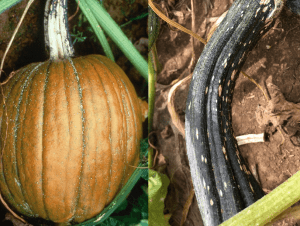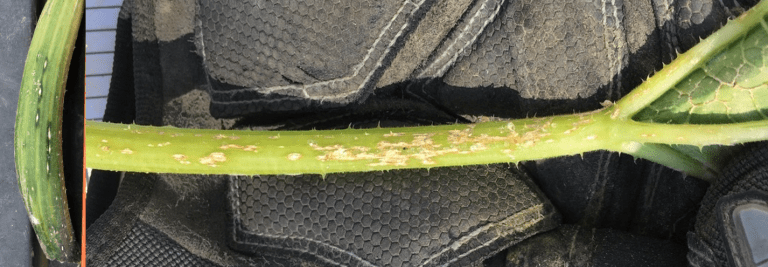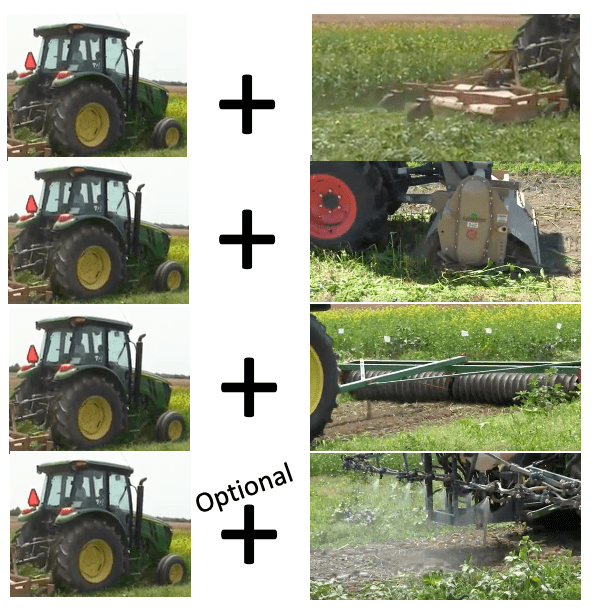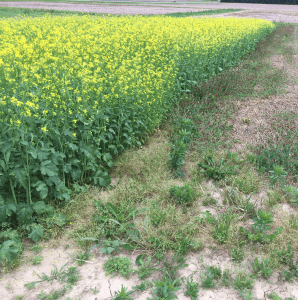
Pumpkin & Squash Growers Wanted for On-Farm Mustard Biofumigation Trial
March 26, 2020 | By Jim Jasinski

Plectosporium blight on fruit and handle.
This article was originally published on February 18, 2020. At this time, Jim is still looking for a few cooperators in southern Ohio. If you are interested contact Jim at 937-484-1526 or jasinski.4@osu.edu
 In 2019, research was conducted into the use of mustard cover crops as a biofumigant to reduce a specific soil borne disease in pumpkins, Plectosporium blight, also known as white speck or Microdochium. The signs of this disease start out as spindle shaped lesions on the petioles, vines and back of leaf veins potentially killing the plant. If the disease progress, it can infect the handles and turn immature and mature fruit white.
In 2019, research was conducted into the use of mustard cover crops as a biofumigant to reduce a specific soil borne disease in pumpkins, Plectosporium blight, also known as white speck or Microdochium. The signs of this disease start out as spindle shaped lesions on the petioles, vines and back of leaf veins potentially killing the plant. If the disease progress, it can infect the handles and turn immature and mature fruit white.
Although our trial in 2019 was planted in a Plectosporium infested field, very little disease developed due to the near drought like conditions at the research station in South Charleston. In wetter locations around Ohio this disease was seen last year and we still think there is potential for this cultural technique to reduce disease in pumpkin and squash fields. To accomplish this on a wider scale in 2020, we plan to replicate and expand our mustard cover crop (MCC) biofumigation study to include on-farm trials with growers.
We are looking to recruit 4-6 growers preferably in the central or southern part of the state to put out a mustard cover crop biofumigation trial to reduce soil borne disease pressure with the following guidelines and conditions.
Growers requirements and general protocol:
- Growers must plant in field known to have a Plectosporium blight infestation. Growers with fields infested with Fusarium or Phytophthora will also be considered.
Equipment needed to successfully manage a mustard cover crop. 
- Growers need to have equipment to seed the cover crop, chop (bush hog or flail), incorporate (rototill), pack the soil (culti-mulcher) and possibly seal the soil using a sprayer or irrigation system. These steps will be done in rapid succession so 3-4 tractors are ideally needed, each hooked to an implement.
- Growers will put out 4 strips of MCC and 4 strips without a MCC.
- Strip sizes will be up to 0.1A for a maximum of 0.8A needed for the entire on-farm study.
- Growers will plant Caliente Rojo, currently the highest yielding glucosinolate mustard cover crop available.
OSU will provide:
- The MCC seed, the fertilizer (urea + granular ammonium sulfate) and 1K seeds of the pumpkin hybrid Solid Gold (Rupp).
- Also evaluate each grower site for disease incidence on foliage three times during the season, plus a harvest where mature fruit are weighed and graded for disease.
Study Timeline:
- The MCC strip plots fertilizer will be disked into the soil prior to seeding to ensure high biomass production.
- The MCC planting date will be between March 30 and April 30 based on soil conditions and weather forecasts.
- Approximately 50-60 days later, the MCC will be at peak flowering and will be chopped, rototill incorporated into the soil and then packed using culti-mulcher. If irrigation is available, water will be applied to help seal the soil and create a better environment for biofumigation.

- Within 10-14 days of incorporation, Solid Gold pumpkins will be transplanted into those strips at roughly 4ft spacing between plants. Note that transplants are preferred at each site instead of direct seeding, but if this is not possible, we can discuss options. Transplants will lead to an earlier harvest.
Plot Care:
Each farm will follow their own standard weed, insect and disease control and fertility practices on the 8 strips. The fungicides used on the crop will need to be discussed ahead of time so we can limit the use of fungicides that might help control Plectosporium blight. These fungicides are Flint, Cabrio, Quadris, Inspire Super and Merivon.
Disease ratings of incidence on vines, foliage and fruit will be taken at 14-21 day intervals from vining until fruit maturity. Sections of all strips will be harvested and fruit will be weighed and graded for disease.
The Big Picture:
By expanding the number of sites for this research through on-farm trials, we expect to see the potential MCC may have to reduce the soil borne disease complex affecting cucurbits. By recruiting growers into this process at a small scale, we hope to gain their valuable feedback as to the feasibility and challenges of using MCC on their farm. If successful, growers will spread the news to other growers who might be willing to try MCC on their farm. In addition to the potential biofumigation benefit, growers will be enhancing their soil organic matter levels and provide premium although brief pollinator habitat during flowering.
If growers want to see a video detailing the steps and processes involved with planting MCC as a biofumigant, check out the work we did in 2019 at https://youtu.be/Taz-PhDphhA.
Sign up:
If interested in participating in this project or have questions, please contact me at 937-484-1526 or jasinski.4@osu.edu by March 14.
This project is being funded by the Ohio Vegetable and Small Fruit Research and Development Program and the IPM Program
A follow-up article can be found here.